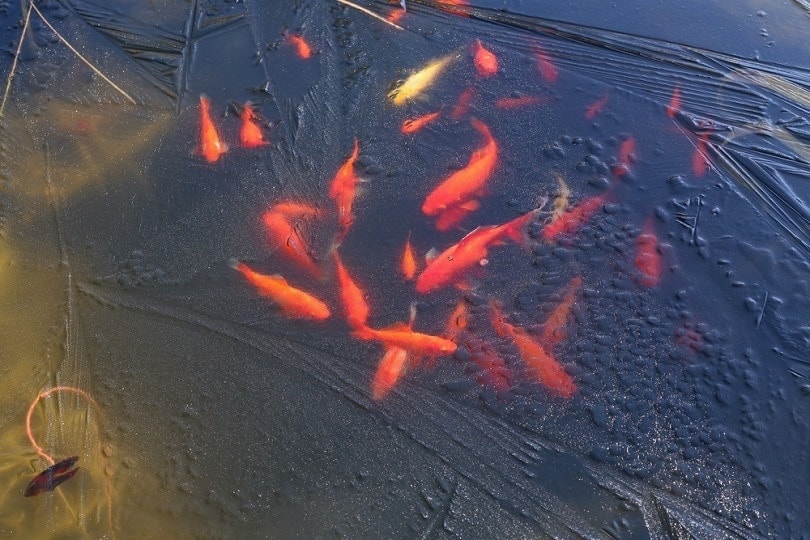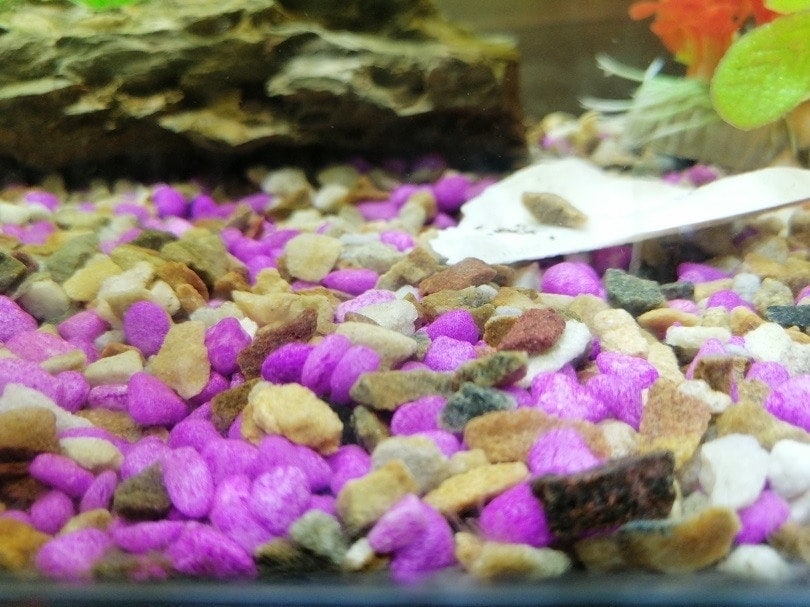Can Goldfish Survive Being Frozen? Vet-Approved Safety Information

Updated on

If you have perhaps accidentally let your goldfish pond freeze solid during the wintertime, you may be wondering if your goldfish could survive. The simple answer is no. Unfortunately, goldfish cannot survive being frozen for long periods, with the potential exception of a few seconds, though this cannot be guaranteed. Goldfish are not able to come back to life after being truly frozen, regardless of any stories you may have heard (which likely have misleading backstories even if true).
Goldfish are coldwater fish by nature and can only survive in an acceptable range of temperatures within your pond or aquarium. There are certain limits to the temperature a goldfish can survive in, and that is at below zero and frozen for more than 5 minutes. The goldfish will ultimately die due to shock.
If you have rescued your frozen goldfish, but they are frozen stiff, you will not be able to revive them.
Why Can Goldfish Not Survive Being Frozen?
It all comes down to your goldfish’s biological makeup of cells. A goldfish does poorly in sub-zero temperatures even if they are still alive. A goldfish should have access to a stable temperature that does not fluctuate out of their danger zones.
The acceptable temperature range for goldfish, whether they’re kept indoors or outdoors, is 16–22˚C (60.8–71.6˚F). Their optimal temperature for growth, immunity, and reproduction is between 20˚C (68˚F) and 22˚C (72˚F). In nature, wild goldfish cousins (carp) are typically exposed to cold temperatures in the winter; common goldfish in ponds can tolerate water as cold as 0–4.4˚C (32–40˚F).
However, goldfish cannot survive being frozen all the way through. So, if their pond freezes along its entire depth during the winter, they will indeed perish. They can only survive lower water temperatures, not ice.

Goldfish Cell Biology and Cold Endurance
Goldfish have delicate membranes that will rupture when they expand. It happens when tiny ice crystals form on them, which is usually a few minutes after being exposed to sub-zero temperatures. It is the main cause of death after they have been frozen and is a painful process that is slightly numb due to the goldfish’s body going into a survival tactic and slowing their metabolism down.
Goldfish are adapted to survive in temperatures as low as 0–4.4˚C (32–40˚F). Their body goes into winter sleep, and they will not eat and will remain inactive. If they are exposed to this temperature for a long time, they will slowly die.
Among all the new goldfish varieties being produced, especially the fancy varieties, their adaptation to this survival method is lessened. Fancy goldfish do poorly under 18˚C, as their genetic digestibility will decrease more than a hardy common or comet goldfish. Fancy goldfish have lower tolerances to changes in temperature and should be kept at 20–23˚C (68–74˚F).
If you're a new or experienced goldfish keeper who’s struggling to figure out the best temperature for your goldfish family, check out our best-selling book on Amazon, The Truth About Goldfish, which covers everything about tank maintenance practices, maintaining optimum fish health, and more!
This crucial aspect of the tank setup could be affecting your pet’s health more than you suspect. which

How Long Can Goldfish Be Frozen For?
A goldfish exposed to freezing temperatures can survive for a few hours till its body completely freezes over. Once they are stiff and covered in specs of ice they have passed away.
If the goldfish are in a pond that has frozen over, they will most likely survive for a while until their body takes too large of a toll. Fancy goldfish are not able to handle frozen ponds. Trying to ensure that the pond does not freeze over is important, as there is no guarantee a goldfish will survive.

How to Revive a Goldfish in Temperature Shock
If your goldfish has been exposed to extremely cold temperatures but is not yet frozen, you will need to place them in a container of their tank water. Slowly add dechlorinated warm water (around 25˚C/77˚F) every 5 minutes via a syringe. Do not rapidly increase the temperature. Ensure that a degree goes up every 45 minutes. Once the thermometer reads 10˚C (50˚F), you can stop the warm water method and place them in a warm and insulated room. They should start to become active, but still not their usual self. As the temperature reaches over 15˚C (59˚F), they should become more active.
- Aerate the pond; keep the surface moving constantly to break up ice formation.
- Add a 150W to 300W heater to the pond. The heat will keep the pond warm enough to avoid ice formation.
- Use a tool like a screwdriver to crack and remove the slates of ice that cover the pond
It is best to take your goldfish inside over cold winters. An indoor pond, aquarium, or temporary housing, such as a kiddie pool or plastic storage container, can be turned into a makeshift aquarium.
Can a Truly Frozen Fish Come Back to Life?
A goldfish that has been truly frozen for more than 5 minutes will have died. Experiments that have been carried out have frozen the fish for less than a minute. The fish is in pain but is still alive, as ice crystals have not yet formed.
Final Words
Keeping goldfish at their ideal temperature is the best precaution you can take. Although we may expect goldfish to survive being frozen, they do not. Care should be taken when attempting to revive them.
We hope this article has helped clear up some questions!
See Also:
Featured Image Credit: Wirestock Creators, Shutterstock











